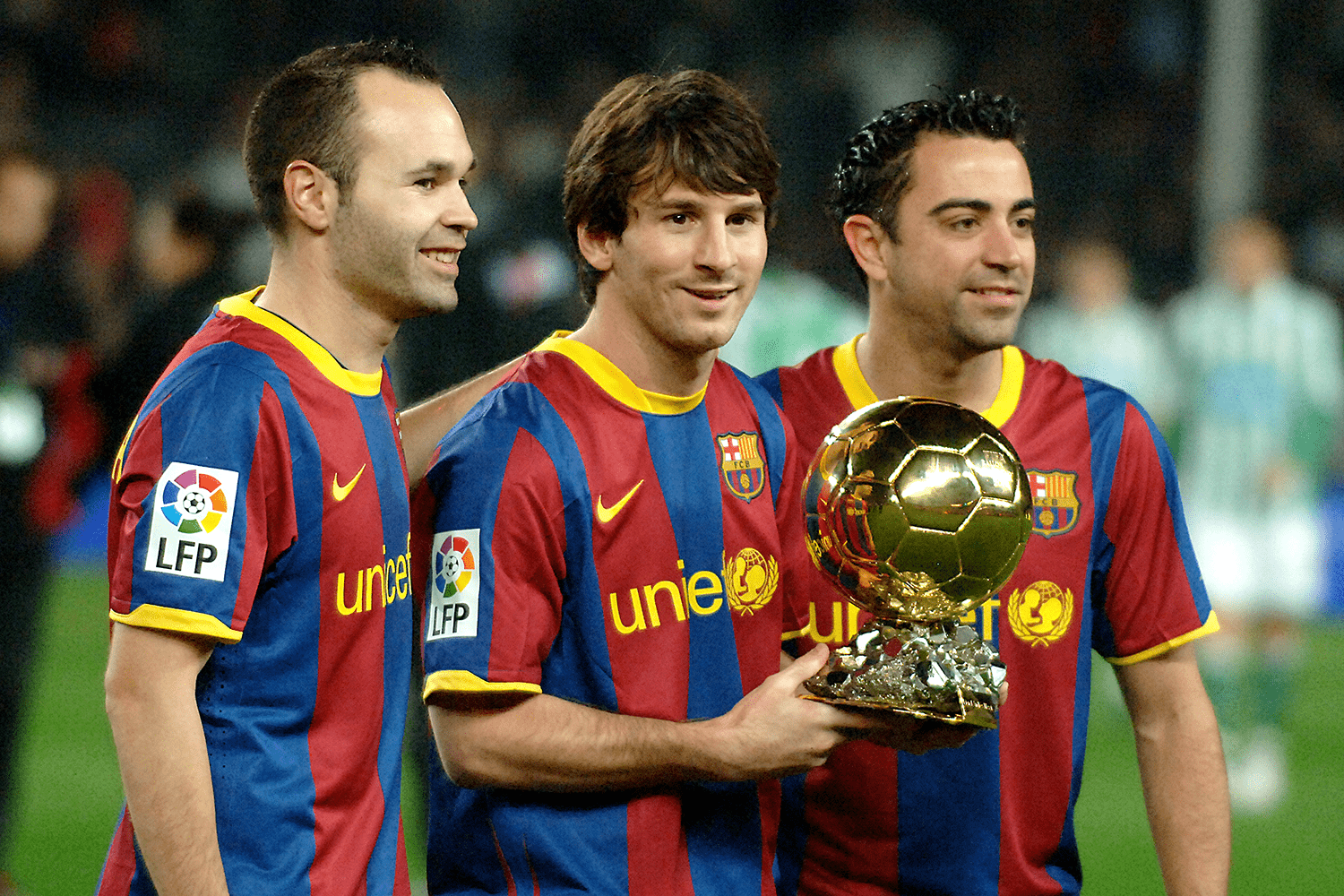There is no doubt that Messi would likely have become the world’s best regardless of who coached him at Barcelona, but it’s also clear that the Pep Guardiola era saw him take a large step forward in his play. Guardiola spent four years in charge at the Nou Camp and during that time saw almost unprecedented success, with three La Liga titles, two Champions Leagues, two Club World Cups and a host of other trophies. For Messi, the period saw him transform into a goalscorer of few, if any, peers, with the last of Guardiola’s seasons, 2011-12, seeing him score a record 50 La Liga goals. In total across these four La Liga seasons Messi scored 138 goals and provided 55 assists, and one thing that was notable was that he was the constant attacking force in the Barcelona team. Guardiola continually tinkered with his attack in the transfer market, before finding a way to consistently shuttle Messi into the centre, a position that saw the goals totals rise to such high levels.
For 2008-09, Samuel Eto’o and Thierry Henry were his main forward companions. Eto’o scored 30 La Liga goals, and Henry 19 to go alongside Messi’s 23. With 72 goals between them in the league, 100 in all competitions and a sweep of trophies, it would have been easy to continue, but Guardiola was quick to change and the summer of 2009 saw Eto’o traded out for Zlatan Ibrahimović and the following season saw Henry used more sporadically and the emergence of Pedro as a contributor from either flank. Messi himself led the goal totals for the first time with 34 league goals and the team racked up a record 99 points but the blend with Ibrahimović was deemed unsatisfactory, and he and Henry moved on. David Villa was the next piece of the puzzle to arrive ahead of 2010-11.
This move saw Messi deployed centrally more often, with Pedro again versatile from the flanks and Villa able to support from the left. Messi again led the Barcelona scoring charts, this time with 31 La Liga goals, 53 in all competitions contributing to 98 all-in between the three. This team once more landed La Liga and the Champions League and by now, Messi was a certainty for all the world’s top player awards, as he had been for the whole of the Guardiola tenure. Strength in depth was the plan for 2011-12 with Cesc Fàbregas and Alexis Sánchez joining the attacking rotation, but Messi remained the main goal outlet, and spent more time centrally than ever before. Though success came exterior to the league and Champions League, Messi’s personal contribution this season was truly exceptional. His shot map for 2011-12 is ever bit as good as might be expected from one of the great goalscoring seasons in history:
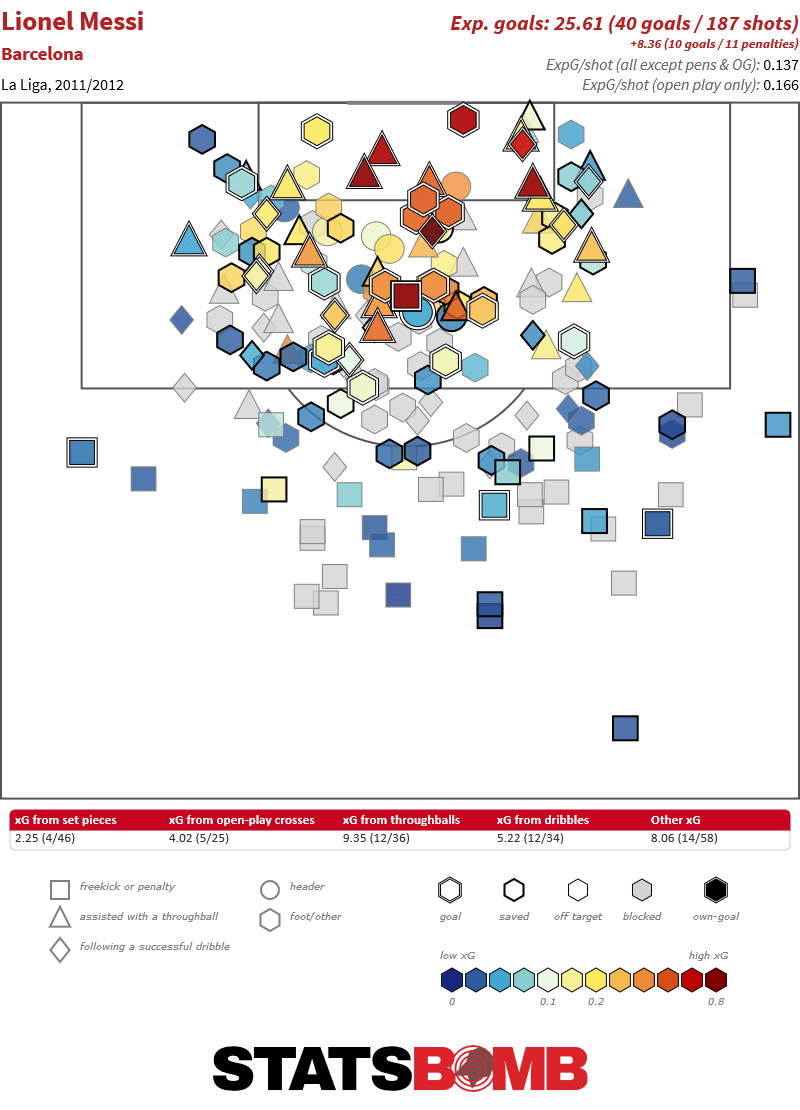
There is almost no fat to trim off from this chart, let’s see how that works if we split into direct free kicks and all other shots:
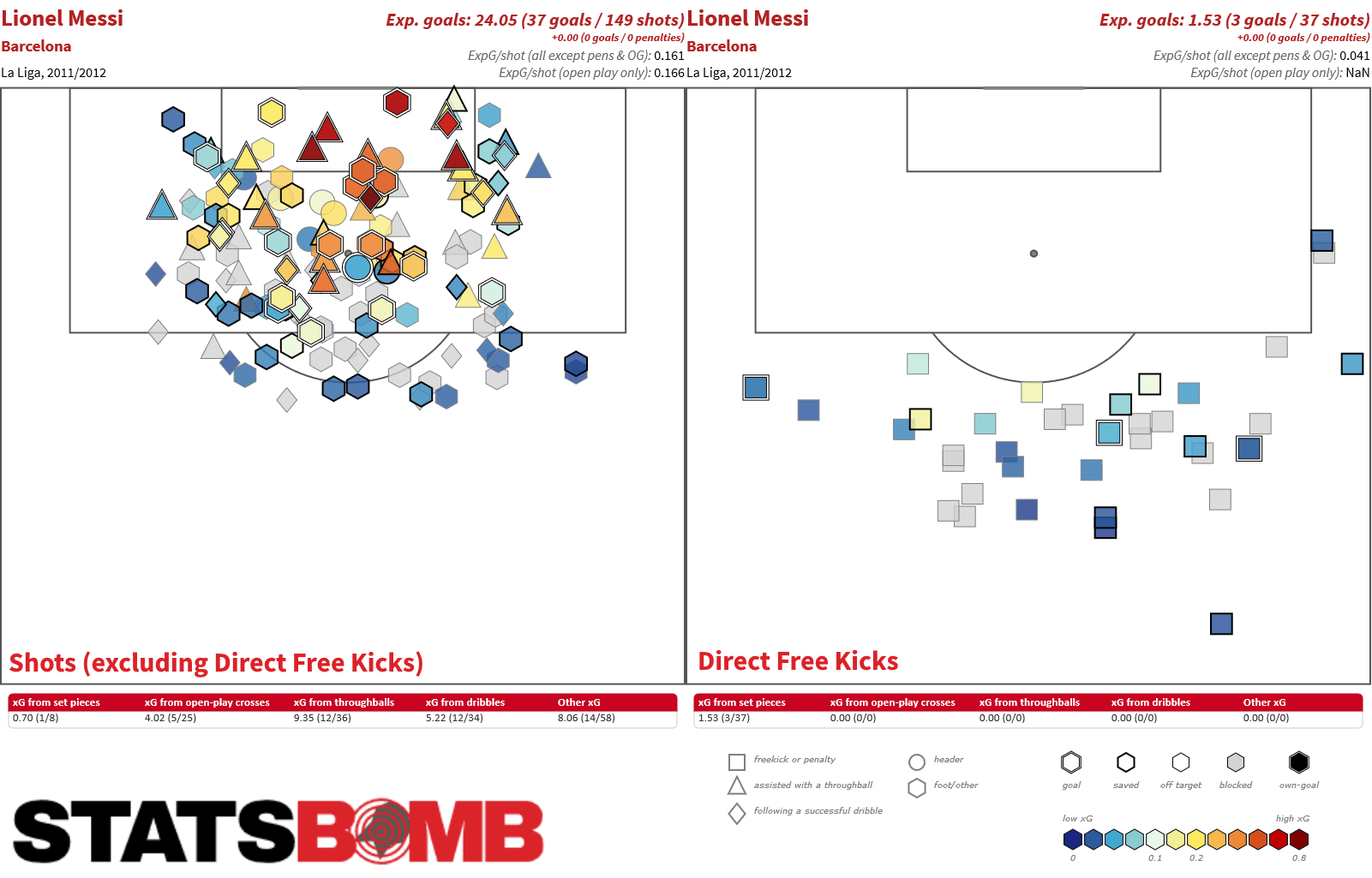
That segmentation is enough to make an analyst’s heart sing. If you ever want to make a point about preferred shot locations, show people this chart. The best goalscoring season on record had an almost perfect set of non-free kick locations: central and mostly close. It’s so tidy that it’s hard to presume that it’s not the result of instruction. By way of contrast, the free kicks, a free hit after all, are the only shots that populate the deeper zones and this was the first season that Messi took a large volume of them; he scored three. Beyond that the shot map is a marvellous blend of goals from throughballs (12 from 36 shots), goals after a dribble (12 from 34 shots), goals from crosses (5 from 25 shots) and even one from a set piece situation (for completeness it should be stated that some categories overlap).
Real Madrid 2-6 Barcelona, the False 9
But how did Messi get to the centre? He spent most of his early seasons ripping up the right flank. We saw in earlier charts that preferred shooting zones we borne of driving in from the right hand side. Those shots are no longer entirely prevalent here. To identify the moment the centre became Messi’s domain, we have to flip back to May 2009 and a famous 6-2 drubbing of Real Madrid at the Bernabéu.
There is some contention as to whether this game was the first time Messi slotted into the “false 9” role (Graham Hunter in Barça suggests otherwise, while the some of the players suggest a plan was hatched specifically ahead of this game) but it came to be known as the game in which the role was defined, for Messi at least.
We can see how Messi’s actions in that game varied from what came before by looking at his pass receipts and comparing them to the season up to that point:
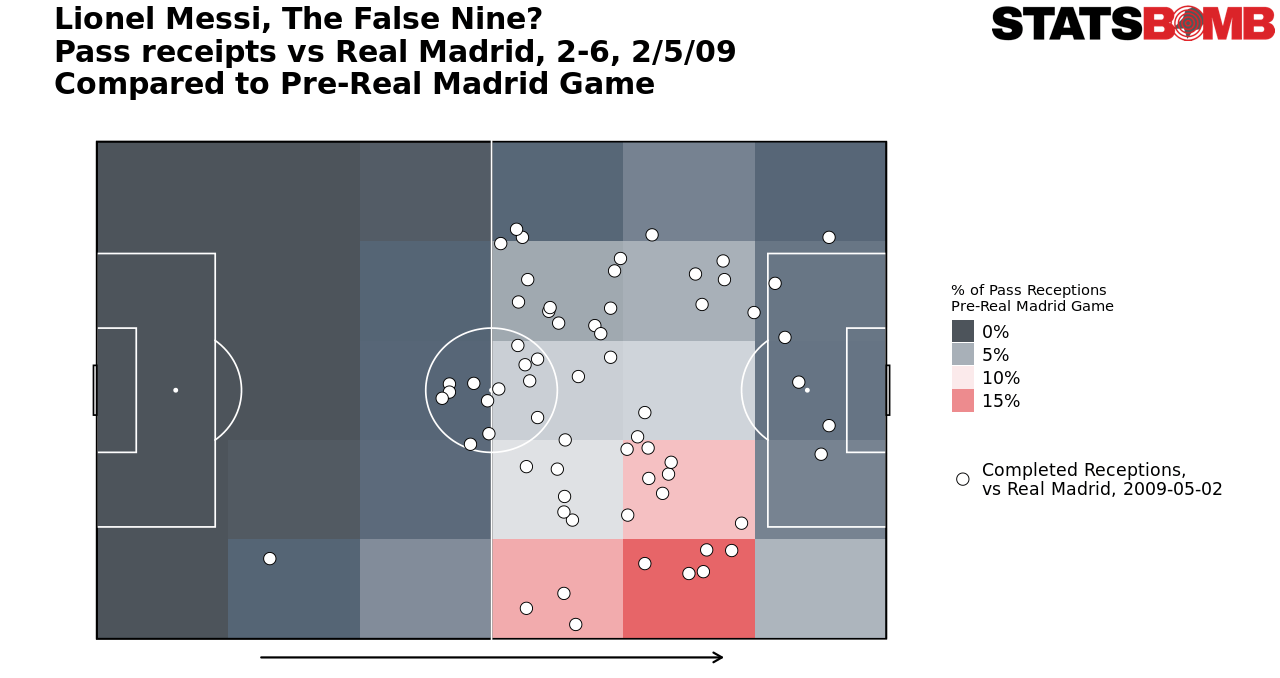
And there it is, not just central but on the whole fairly deep too, and drifting from side to side.
The pass map for the whole game reflected this well too:
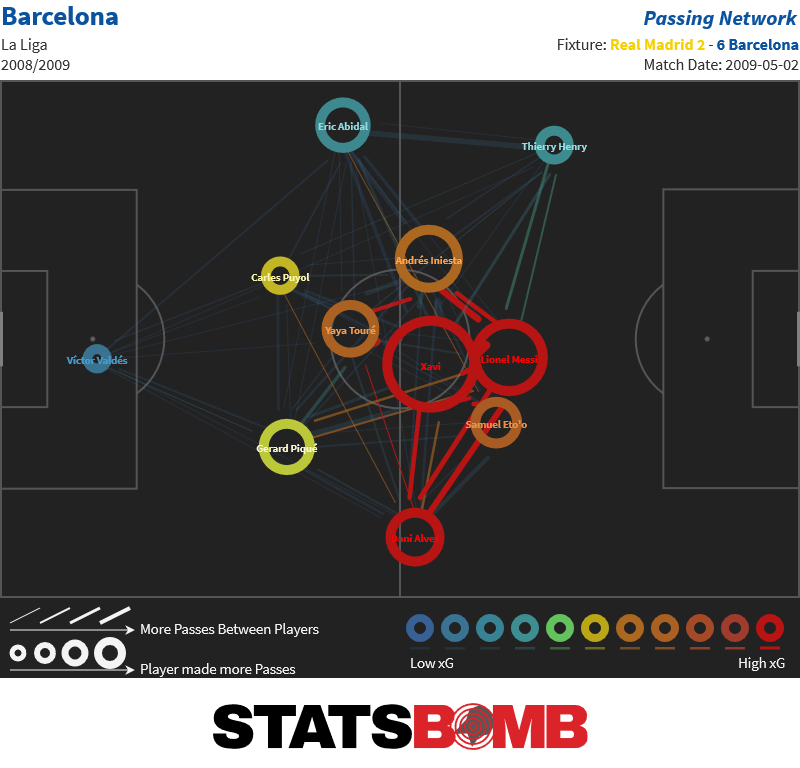
The match and the result became iconic. Barcelona ran out 6-2 winners and after Real Madrid cut a 3-1 deficit back to 3-2, they didn’t take another shot. Messi himself had a stellar day. He was responsible for ten of Barcelona’s shots (seven shots, three key passes) and helped himself to two goals and an assist. On the day, Xavi was the perfect complement to Messi, with six key passes generating three assists himself and the two of them were passing for fun in the final third, completing 33 (Xavi) and 32 passes respectively, no other player completed more than 14.
First free kick scored
We looked at free-kicks in last week’s piece, and established that Messi took time to adopt the role for Barcelona, not least because Ronaldinho was the primary taker throughout the Frank Rijkaard era. Under Guardiola, Messi slowly graduated towards the role of main taker for Barcelona, but the job was shared, at least for Guardiola’s first two seasons, with Dani Alves and Xavi both capable and contributing, while Messi was part of that roster. His first actual free kick scored in La LIga was impudent and audacious. Check out this freeze frame:

There’s no error here. Messi really did score his first La Liga free kick against this defensive set-up. The game had already started badly for Atlético Madrid and they were 2-0 down after five minutes. Soon after, and evidently in some disarray, Atlético Madrid fouled Messi in a dangerous area high up the pitch. They started to set up their wall, but never got there. At the point Messi shot, goalkeeper Grégory Coupet was coordinating from his near post and Raúl García was attempting to slow down the taker. Messi had other ideas, checked quickly with the referee, and lofted the ball into the open side of the goal to make it 3-0. Atlético were dead and buried after 8 minutes and went on to lose 6-1. Messi was on the board for La Liga free kicks, with a piece of quick thinking that paid off.
Still the dribble master
The Guardiola era may have coincided with the growth of Messi as a goalscorer, but it didn’t see any particular regression in the volume of dribbles he was completing on a game by game basis. The highpoint of 8.6 per 90 in 2007-08 was not matched but in each of these four seasons, Messi was completing over six dribbles per 90 with 7.5 per 90 in both 2009-10 and 2010-11. There was also subtle progression in the percentage of dribbles he completed. In his early seasons he averaged around 65 to 68% but became a consistent 70% man across the final three seasons of Guardiola’s reign. He also exceeded his single game record of 18 (vs Recreativo Huelva, November 2007) in a frustrating 2-2 draw against Almería in March 2010 when recording 22:
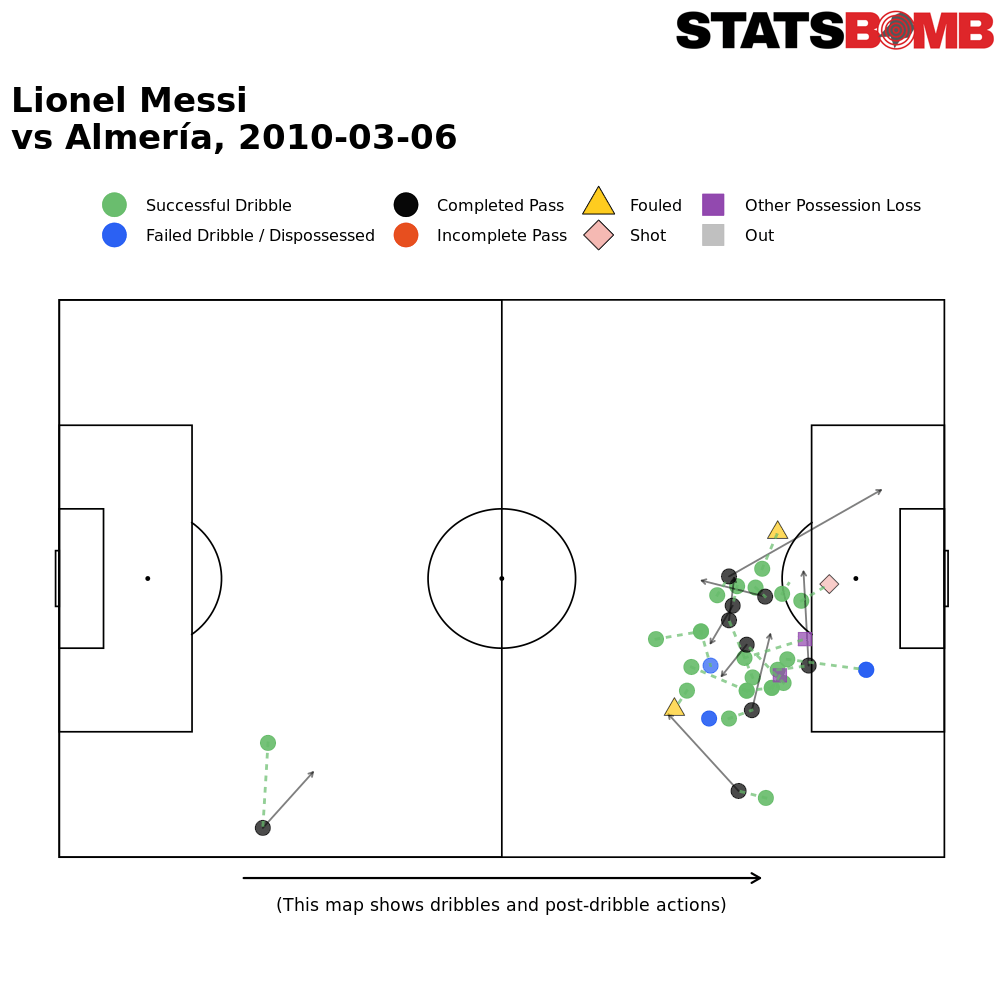
A fascinating cluster of dribbles in that one zone. Messi also equalled his record for number of times he dribbled past a player in a single game twice in this game, having beaten both Fernando Soriano and Modeste M’Bami six times in amongst that cluster. He also created 15 of Barcelona’s 22 shots that day (taking 11 and creating 4) and scored twice. Despite this utter and singular dominance from Messi, the match was drawn as Barcelona conceded an own goal and a set piece, and couldn’t find a decisive goal.
Lionel and Dani, a perfect match
When Dani Alves left Sevilla in 2008 (reportedly in tears) to join Barcelona, few can have expected how he would become Messi’s perfect sideman in the seasons to come. Consistently we see Alves as the main supplier to Messi both in creating shot volume and assists:

Even when Messi moved more to a more central position as Guardiola’s tenure developed, his faithful full back continued to be his main supplier. It is quite scarce to see such an entwined partnership such as this, and while 21 assists from Alves to Messi across four seasons may not instinctively appear to be a high volume, it genuinely is. There was more to come too as these are only half of the eight seasons Dani Alves and Messi shared at Barcelona. It’s also worth noting the relationship Messi struck up instantly with David Villa in 2010-11. They combined for 12 goals that season (Messi assisted Villa for eight goals, Villa to Messi for four more) and it was unfortunate that Villa suffered a broken leg that ruled him out of the second half of 2011-12 and that summer’s European Championships.
Messi the Passer
With eight seasons now in the tank, it’s a good time to look at the evolution of Messi the passer:
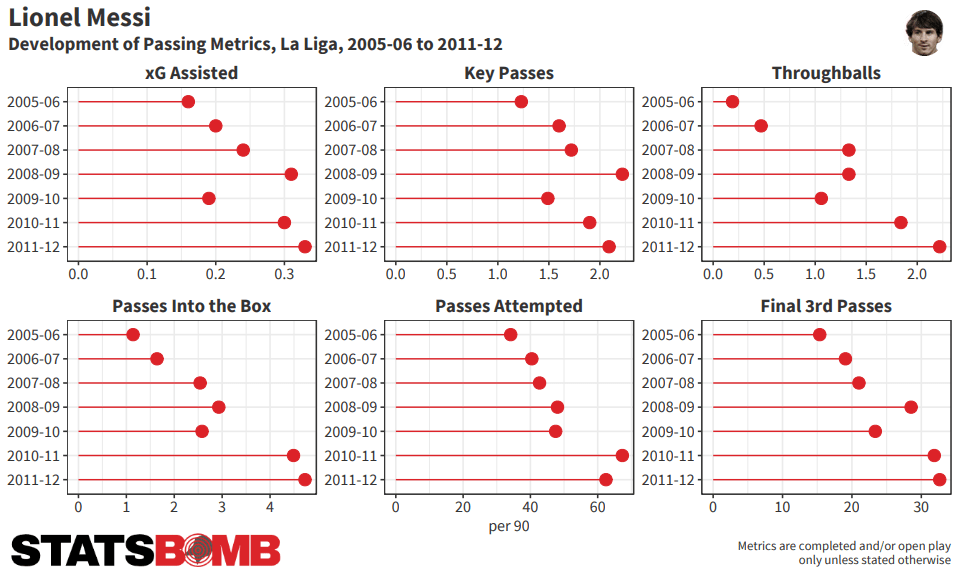
We see here a fairly linear growth across a variety of metrics, interrupted only by a comparatively stagnant 2009-10 season. The subsequent quick departure of Ibrahimović allowed Messi to move to a central position, which he predominantly inhabited across the last two seasons of Guardiola’s reign and beyond, and it also caused an uptick across a bunch of passing related metrics. Playing centrally, Messi’s open play passes completed into the box increased from around three per game up to over four. The amount of passes he attempted in general leapt forward from mid to high 40s to up well over 60 per game or which many were in the final third. Messi was dropping deeper playing here, but his pass volumes were increasing all over the pitch. And from this beneficial vantage point, he completed more throughballs than ever before. With combinations of Pedro, Villa, Fàbregas and Sánchez zipping around in front of him in 2011-12, his rate of over two per game was double that of the one season with Ibrahimović in 2009-10.
We can also see how the position change affected Messi’s directions of passing:
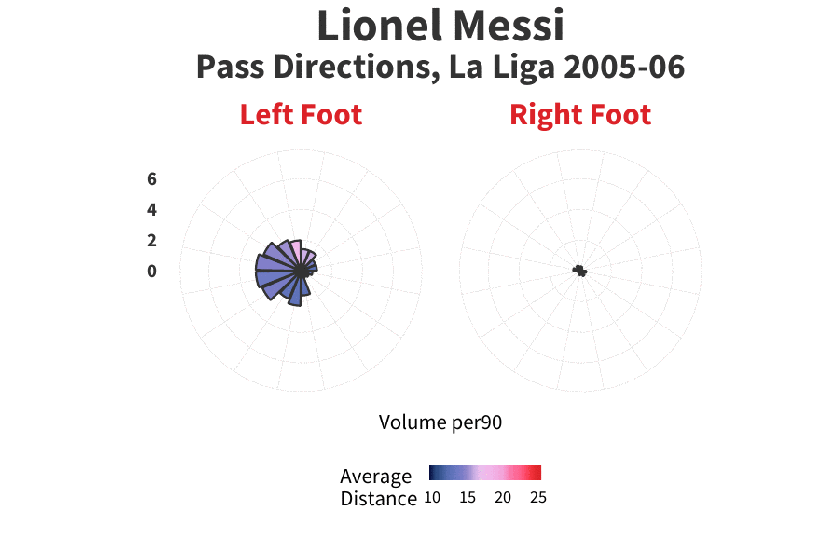
Ever left footed, Messi’s early seasons from the right see an obvious but distinct pattern of passing forwards but to his left. The average distance of his passes is never long, but has three distinct phases: across 2005-06 and 2006-07, we see volumes of between 34 and 40 per 90 and an average distance of a shade under 16 metres per pass. The next three seasons volumes kick upwards from 42 in 2008-09 to nearly 50 in the following two years. The distances increase to between 17.5 and 18.0 metres on average, and the directions are maintained, from the right to the left. Finally the switch to a more central position adds around 20 passes per game, the distance contracts again and the directions are far more varied, albeit the overarching left to right skew is maintained, at least in 2011-12. Messi has certainly evolved across the sample though and for a central forward of any variety to be logging an average of sixty-plus passes a game is almost certainly unique.
In truth there are endless angles one can examine for this period of Messi’s career, but hopefully this article gives you a flavour of how he evolved under Guardiola. The raw data for this period will be released tomorrow (Tuesday 23rd July) and will be available for free alongside the first four seasons of Messi’s career from our resource centre. Lots of people have already been busy working with this data and posting results on twitter and Euan Dewar’s guide to using StatsBomb Data in R (download the PDF within) is available in both English and Spanish, so get involved. Many thanks also to Euan for background research and visualisation work within this piece.
Next week: Messi Data Biography #3: Peak Messi and the arrival of Neymar and Luis Suárez

